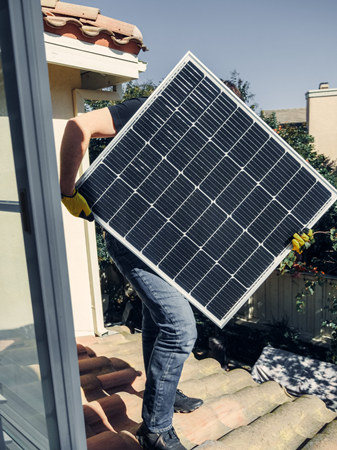How to Get Free Solar Panels from the Government in 2024
Typically, “free solar panels” programs refer to solar leases, PPAs or government programs for low-income households. Here we will discuss the third one: How to get free solar panels from the government in 2024.
With certain Federal, State and Local government solar incentive programs available, it is possible to get low-cost solar panels from the government. These incentives help offset the cost of installing solar systems and allow homeowners to save money when switching to solar.
Ready to find out what solar incentive programs are available and how to get solar panels from government free and save money on going solar? Keep reading to find out.
What are free solar panels?
Free solar panels refer to solar panel systems provided at no upfront cost to homeowners. Instead of paying for the installation and equipment, homeowners can take advantage of various programs and incentives that cover these costs. However, it's essential to understand the different models and what "free" truly means in this context.
Government Incentives and Rebates
Governments offer incentives and rebates to promote the adoption of solar energy. These incentives can significantly reduce or eliminate the cost of installing solar panels. Federal tax credits, state rebates, and local incentives are common ways to offset the costs.
Solar Panel Leasing Programs
In solar panel leasing programs, companies install solar panels on your property, and you lease the system. You typically pay a fixed monthly amount, which is often lower than your previous electricity bill. The leasing company maintains ownership of the panels and is responsible for maintenance and repairs.
Power Purchase Agreements (PPAs)
With a PPA, a solar provider installs solar panels on your roof, and you purchase the electricity generated at a predetermined rate. This rate is usually lower than the rate charged by your utility company, providing immediate savings without the upfront costs of solar panel installation.
How to Get Solar Panels from Government Free?
Everyone dreams of getting government free solar panels for home or a commercial property, but it’s nowhere near as simple as that. Actually, there’s no such thing as free solar panels from the government, but various incentives and programs can reduce the installation cost of solar systems. Here are some of the best solar incentives the government offers right now:

Solar Investment Tax Credit (ITC)
The ITC allows homeowners to claim 30% of their solar installation costs as a credit toward their federal tax bill. This credit is available for systems installed and operational before December 31, 2032.
Solar Renewable Energy Credits (SRECs)
SRECs are earned for every megawatt-hour (MWh) of electricity your solar system generates. These credits can be sold in states with solar carve-outs, providing additional income.
Performance-Based Incentives (PBIs)
PBIs reward you for the electricity your solar system produces. Payments are based on the actual output of your system and can vary by state and utility company.
State Tax Credits
Several states offer additional tax credits that can be claimed against your state tax liability, further reducing the net cost of your solar installation.
Net Metering
Net metering policies allow you to sell excess electricity generated by your solar panels back to the grid, providing a credit on your utility bill. This can help to further offset the cost of your energy consumption.
By taking advantage of the various government incentives available, you can get solar panels from the government at a reduced cost. Remember that all of these incentives have different criteria and paperwork involved, so it is important to research to ensure you are eligible for the program and understand the application process.
Reasons why the U.S. Government Introduced Solar Incentives Programs
Indeed, solar has quickly become the toast of communities eager to live greener and reap the environmental and economic benefits of solar energy generation. But why did the U.S. Government introduce free solar panels government programs, and what are they meant to achieve?

Firstly, solar incentive programs help owners recoup their system costs over a reasonable period. For commercial customers, the recoup period is five years, while residential customers have a span of 10 years. This helps reduce the risk associated with the cost and encourages more people to switch to solar.
Another aim of the program is to encourage efficient solar system designs. Performance-based incentives (PBIs) are used to encourage the design of systems that have peak energy production. This encourages solar system owners to proactively install, manage and maintain their systems.
Finally, these incentives help to jumpstart and support a vibrant local solar industry. Firstly, subsidies and tax incentives make it more affordable for people to transition to solar. This increases sales volume and consequently contributes to more competition in the local markets. Thus, it helps to drive down the cost of installation even further.
The U.S. Government’s introduction of Solar Incentive programs has some formidable benefits that can help make the transition to solar easier and more profitable. Ultimately, the incentives are all geared towards ensuring a greener and brighter energy future, something we can all get behind.
Where to Get Information About Solar Panels Incentives and Rebates
Reducing energy bills and having the sun power your home may sound appealing. But the hoops you need to jump through to get incentives and cut installation costs can be overwhelming. Fortunately, there are a few ways to get reliable and accurate information about solar panel incentives and rebates.
One of the most comprehensive and up-to-date sources is the Database of State Incentives for Renewables & Efficiency (DESIRE), which provides a comprehensive list of solar incentives and policies by state. Not only is it regularly updated with information, but it also provides detailed guidance on each policy and incentive.
Another great resource for information about solar incentives is the Solar Energy Industry Association (SEIA) partner SolarReviews. They feature a resource page for solar incentives, including state-by-state solar data updates. The page breaks down incentives by incentives by state, tax credits, and other financing programs.
Finally, nothing beats speaking to your installer directly. Not only can your installer provide you with the most up-to-date information on solar incentives in your area, but they can also explain how those incentives can apply to your specific project.
Conclusion
Getting free solar panels from the government may be hard but getting solar panels with good quality and nice price is not very difficult. Renogy is a good choice when it comes to buying solar panels. With nearly 15 years of dedicated solar experience, we're the top-rated U.S. solar company provided kinds of types of solar panels for you.
FAQ
Are free solar panels truly free?
They often come with no upfront cost, but may involve long-term contracts or fees.
How much can I save with free solar panels?
Savings vary but can be substantial, depending on your energy usage and local electricity rates.
Which states get free solar panels?
There are no states that offer free solar panels. You may find specific government agencies that subsidize solar panels as part of an energy efficiency assistance program, but these benefits are usually exclusive to low-income households. The Database of State Incentives for Renewables and Efficiency is an excellent resource where you can check solar incentives and tax credits by state.








